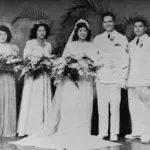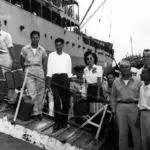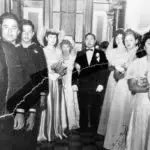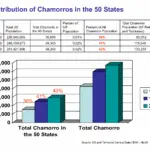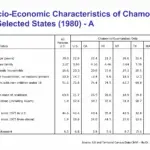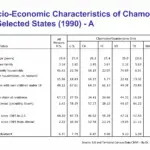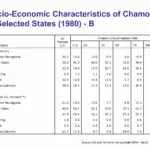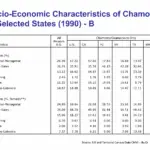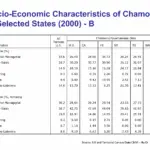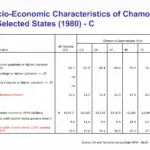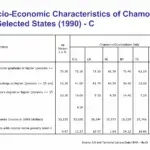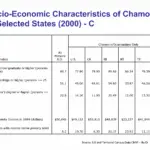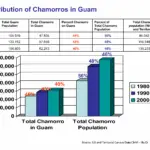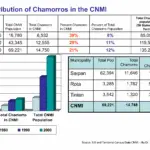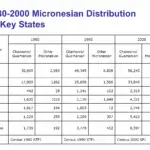Chamorro Migration to the US
Table of Contents
Share This
Editor’s note: This following is part of an independent research done over a 30-year period by Dr. Faye F. Untalan, a professor at the University of Hawaiʻi, Mānoa. It is a descriptive analysis of the trends and patterns of CHamoru/Chamorro migration and settlement in the United States. This paper is based on earlier research, her doctoral dissertation on Chamorro migration and adaptation, completed in 1979 at the University of California at Los Angeles (UCLA). According to the 2000 US Census, there were 135,233 Chamorros in the US, the US Territory of Guam, and the US Commonwealth of the Northern Marianas (CNMI). Of this number, 58,240 were residing in the US mainland (including Hawaiʻi and Alaska). The questions of: “When? Why? Where? Who? How?” of Chamorro relocation to the US are explored in this essay.
Historical background
In 1898, at the twilight of the Spanish-American War, the US claimed Guam as a token of war. Though this event would bring an end to more than three centuries of Spanish colonial rule, it would also begin a new era in which the Chamorro people of the Mariana Islands would experience separation from one another.
As Guam became a possession of the US, the rest of the Mariana Islands, which included Saipan, Tinian and Rota, became the possession of world powers Germany, Japan, and then the US in 1944 (at the end of World War II). Today, Saipan, Tinian, and Rota are collectively known as the US Commonwealth of the Northern Mariana Islands (CNMI). Thus, the Chamorros continue to experience political division; however, family, culture, tradition, and language bind them as one.
Much information about Chamorro migration and settlements in the continental US had been gained from censuses administered by the US government. The first official US censuses began in the early 1900s. US Naval governors conducted the first two censuses in Guam, in 1901 and then in 1910, which were followed by the first official Decennial Census in Guam in 19201.
Pre-WWII censuses in Guam (1901-1940) showed a small population consisting predominantly of the native Chamorros (90 percent). The population in Guam was nearly tripled by 1950; this was a result of the US military build-up and the importation of foreign laborers to aid reconstruction of the island following WWII.
The following table shows decennial census data for Guam from 1901 through 19702:
Guam Census: 1901-2000
| Year | Total Population | Number of Chamorros | Percent of Chamorros |
|---|---|---|---|
| 1901 | 9,676 | n/a | n/a |
| 1910 | 11,806 | n/a | n/a |
| 1920 | 13,275 | 12,216 | 92 |
| 1930 | 18,509 | 16,402 | 89 |
| 1940 | 22,290 | 20,177 | 91 |
| 1950 | 59,498 | 26,521 | 45 |
| 1960 | 67,044 | 34,762 | 52 |
| 1970 | 84,996 | 71,512 | 84 |
| 1980 | 105,979 | 47,690 | 45 |
| 1990 | 133,152 | 57,255 | 43 |
| 2000 | 154,805 | 61,922 | 40 |
Note: US took possession of Guam in 1898; CNMI was under Germany 1898 – 1918 and Japan 1918 – 1945.
These data illustrate the continuing decrease of in the number of Chamorros in their home islands, and the increasing influx of non-Chamorros, a trend that has significantly altered the demographic characteristics of the population in the Mariana Islands. The impact on political and economic conditions has been substantial.
Migration in the US Naval Era
Historically, Chamorros have been a seafaring people noted for their swift proas and ability to navigate between islands in the Pacific, according to documents from early Spanish discoveries. As travel opportunities emerged, the passion for traveling and exploration was ignited. This event was coupled with social, economic, and political forces that were reshaping the Chamorros’ abilities to sustain meaningful and satisfying lives on their islands. This led towards the migration of Chamorros from their native islands to the continental US.
Chamorro migration was spurred by three primary reasons: the call to military service, the pursuit of greater education, and the search for better opportunities. These reasons for migrating are not different from what has been found among the people of most other ethnic or national groups who have immigrated to the US.
Migration to the US began in the early 1900s. The first migrants were young Chamorro men known as “Balloneros” who joined the many whaling ships that stopped in Guam during this period. As a whaler, the Ballonero had the opportunity to travel and work, but definitely to leave the island. For Balloneros, the two major destinations would become California and Hawaiʻi.
While the author was conducting her dissertation in Los Angeles, she met a lady whose last name was Leon Guerrero who claimed her grandfather came to California from Guam as a whaler in the 1920s. In Hawaiʻi, the author met three families, Camacho, Palomo and Sablan, who made the same claim. The Camacho and Sablan families documented their family histories by tracing family names to Guam. Though these Chamorro descendants have long experienced the separation of distance from the Mariana Islands, they continue to acknowledge their Chamorro roots. The author recalls her own grandfather telling her of his unsuccessful attempt to stowaway on one of these whalers’ ships at the age of twelve.
“Who knows how many successfully made it?” is a question that future migration researchers may one day explore. These findings also suggest that Chamorros value travel and adventure.
World War II impact
Chamorros before WWII were relatively unknown to the rest of the world. The Mariana Islands were predominantly populated by Chamorros. It was not until after the war and during the reconstruction era that non-Chamorros had a significant presence on the islands. It was also during this period that a major restructuring of the social-economic structure of the Chamorro people and their culture occurred.
Restructuring included the following:
- Emergency houses were built in villages to house Chamorros after the war; the assignment of families to nuclear-type homes changed familial land residences and separated extended families, and eventually weakened the family structure.
- Wage-based work replaced the predominant agrarian lifestyle, irreversibly altering the economic system and land use.
- Development and improvement of education provided Guam scholars access to higher education and professional training in the US; many remained in the US causing a “brain drain” on the island.
These events paved the way for Chamorros to leave their islands to access resources to improve their lives, many never to return.
Military service
During the early 1930s, the military induction of young Chamorro men into the US Navy led to the first wave of Chamorro military families leaving Guam in the 1940s after World War II. These families settled around US Naval Bases in the California communities of Vallejo, Alameda, Long Beach, and San Diego. The Korean Conflict in the 1950s then led to the induction of Chamorro men into the US Army and Air Force; this induction was intensified by the military draft.
Then and now, “Guamanians” were citizens and therefore, subject to the US Draft Law. Military enlistment had become a major career option for Chamorro young men and now, in contemporary times, for young Chamorro women. Chamorro involvement in military service has been the highest participation per capita found among any ethnic group in the US since the Vietnam War.
As Chamorro men and women left the islands for military service, their spouses and children followed along, sometimes joined by parents and unmarried siblings. Also, many single military servicemen married wives from other places during their military tour. Thus, Chamorros were not only leaving the islands, but were also marrying out.
Mass migration
Typhoon Karen, in 1960, uprooted many families in Guam. These families decided to leave for California out of disappointment with the typhoon’s destruction and encouragement from family members already settled in California.
In the 1960s, a US fruit company recruited Chamorros in Guam to work as “fruit pickers” in California. While many left Guam, attracted by idealistic notions of a life spent “picking apples,” they found conditions were not what they had expected and some soon returned; some remained in the mainland US and searched for work elsewhere. Subsequently, they brought their families to the US where they continue to live.
Pan American World Airways, commonly known as Pan Am, closed its service in Guam in the 1970s; many of their employees went to the US to find jobs. Some Pan Am employees went to work with Pan Am in New York; some moved to California and joined other airline companies.
More recently, Chamorros are leaving the islands due to job relocation, in both military and civilian sectors, and to seek better health care. Job relocation is often predicated by economic conditions; as is often the case, among the general population within the continental US.
The quest to gain adequate medical care however, has created a new type of migrant from the Mariana Islands. New awareness about modern health treatment, the financial ability to access health care, and the lack of quality health care on the islands have motivated many Chamorros to leave their islands to seek care elsewhere.
This migration trend is particularly noticeable in places like Hawaiʻi, where medical care has been provided to many Chamorros through government-sponsored medical referral programs when such medical treatment was not available on the islands. Also, health insurance providers for government employees on the islands have had to use off-island medical treatment sites when local services were non-existent. Sadly, patients and families have had to endure costs related to transportation and living for off-island medical treatment. These expenses have brought on severe economic and social stresses to the families.
Thus, to maintain health care continuity, patients have bought residences in Hawaiʻi or remained in Hawaiʻi. Some had to utilize Hawaiʻi’s public health care programs. In other cases, families moved to other states or joined other relatives living in other states to obtain, or maintain, health care treatment.
Chamorro settlement in the US
The 1980 Decennial Census was the first US National Census to include Chamorros and to count them as an ethnic category within the fifty states. The 1980 and 1990 censuses identified the people from Guam as “Guamanian,” which is neither a racial, ethnic, nor a cultural term for the natives of the island. In 2000, Chamorro was inserted as an ethnicity on the US Census. In previous research, the author discovered that Chamorros from the other Mariana Islands living in the US used “Guamanian” for their race because it was the closest ethnic identifier for them.
According to the 1980 census, the number of Chamorros in the US was 30,695. By 1990, the number of Chamorros grew to 49,345. The most current census in 2000 counted 58,240 Chamorros in the fifty states; this number nearly doubled that of only twenty years earlier. An average increase of 23.6 percent per ten years during 1980-2000 was observed. During this time period, the highest increase in Chamorro population was observed in Florida at 40.5 percent and the lowest in Hawaiʻi at one percent. During 1980-2000 census periods, the largest Chamorro population was located in California. However, according to the 2000 census, Chamorros represented only 0.0618 percent of the California population – which is a decrease from 0.0719 percent in 1980.
While Chamorro settlement in the US has spread throughout the nation, several states are found to have larger numbers of Chamorros in the 1980-2000 Decennial Census. For the purposes of this analysis, five states (California, Florida, New York, Texas, and Washington) were selected because they had the highest number of Chamorros in the US; Hawaiʻi was also selected for comparison because of its proximity and similar island lifestyle. Figure 1 gives the number and percent of Chamorros within these states for the 1980-2000 census years. In census 2000, Florida became one of the states with the highest increase of Chamorros in the US. The migration patterns among Chamorros can be attributed to these settlements.
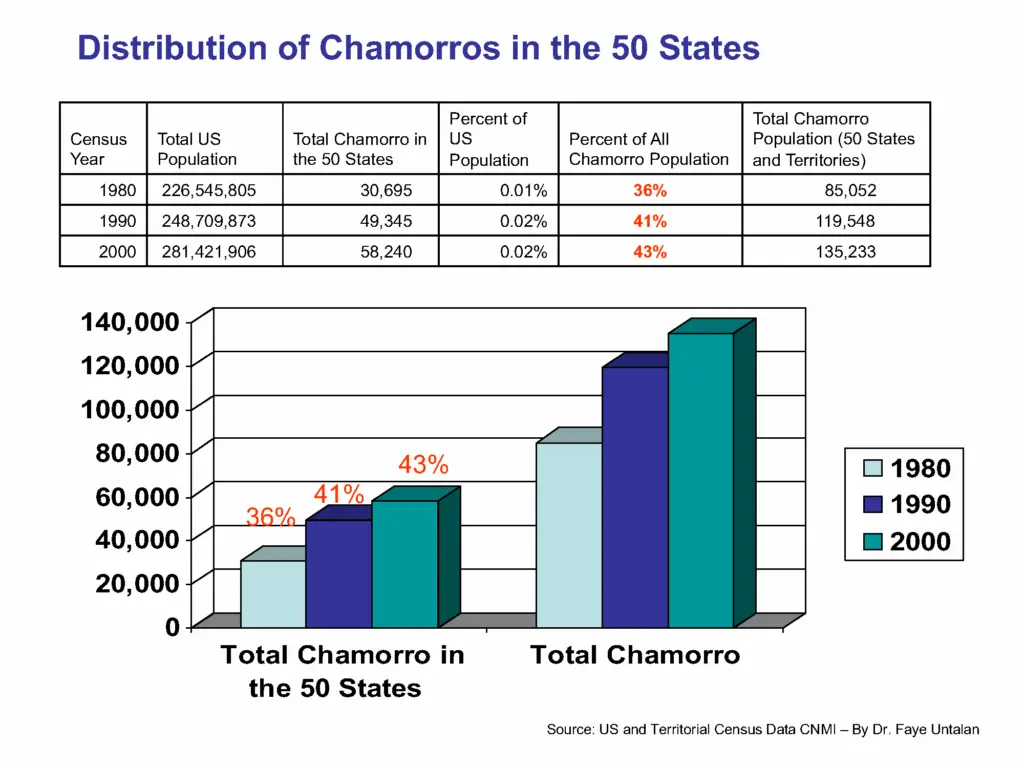
Major characteristics of Chamorros in the US: 1980-2000
The socio-economic characteristics of Chamorros in the states of California, Hawaiʻi, New York, Texas, and Washington taken from the Decennial Census of 1980, 1990, and 2000 were organized into tables for each of the decennial census year. These are given in Figures 2a – 2i. These tables were used to analyze and determine the demographic and socio-economic characteristics of Chamorros living in the US as compared to the general population of the US. This analysis began in 1980 selecting the states with the highest number of Chamorros. Hawaiʻi is of interest to this analysis because of its proximity and utility to the Mariana Islands. For example, the University of Hawaiʻi not only attracted students from the islands but also allowed them to pay state resident tuition until the latter part of the 1990s; Hawaiʻi medical centers were the primary source for medical referral until more recently; and many military personnel from the Mariana Islands were stationed in the military bases in Hawaiʻi. The cost of living in Hawaiʻi was a major factor for many Chamorros who decided to move to Texas and Washington after military retirement.
Chamorros as an ethnic population in the US are slightly younger than the general population of the US. In 1980, the median age was 30 for the US general population and 22.6 for Chamorros; in 1990, it was 33 years for the general population and 25.9 for Chamorros; in 2000, it was 35.3 for the general population and 28.9 for Chamorros. The Chamorro family size was larger, and the percent of families with children under 18, was also much higher than the general population in all three decades. It also appears that most Chamorros were born outside their state residences; most were born abroad, more than likely in their native islands. They also showed much higher movement from abroad in all three decades than the general population. Thus, Chamorros are largely first generation migrants in the US and are also a highly mobile group.
While there are some small variations among the states, Chamorros appear to have higher unemployment than the general population. For both males and females, occupations are predominantly in technical-sales and services. The percentages of Chamorros found in these fields were higher than that found in the general population. The educational gap between the general population who completed high school or higher and Chamorros appear to be slightly narrowing from 1980 to 2000. However, amongst those who have a bachelor’s degree or higher, Chamorros still lag behind the general population in the US in all three censuses.
Median family income was slightly lower for Chamorros than the general population in the US except in the state of California which showed median income for all three decennial censuses for Chamorro to be slightly higher than the median income of the general population. The percentage of families with income below the poverty level was higher among Chamorros than found in the general US population for all three decades.
Chamorro distribution in the US and island territories
In 1980, there were 47,690 Chamorros in Guam, 6,667 in the Northern Marianas and 30,695 in the US for a total of 85,052 Chamorros counted by censuses in the islands and the US. In 1990, there were 57,255 Chamorros in Guam, 12,948 in the Northern Marianas and 49,345 in the US for a total of 119,548. In 2000, there were 61,922 Chamorros in Guam, 15,071 in the Northern Marianas and 58,240 in the US for a total of 135,233 Chamorros. While the population is increasing in all areas, the proportion of the Chamorro population on the islands is decreasing rapidly.
The Chamorro migration experience from their home islands to the US is similar to the experiences of many other immigrants, and what is known as a chain migration. The chain develops when family members follow the first immigrant, after the new arrival has adjusted to the new location, acquired a home and employment, and is able to provide housing and “open (employment or other) doors” for other family members.
Chamorro and other Micronesian migration to the US
Chamorros represent the largest Micronesian Pacific Islander community in the US as found in the census. Taking the states with the highest number of Micronesians, Figure 4 shows the numbers of Chamorros and Other Micronesians in selected states. Other Micronesians are showing a very high increase in these states over the past three decades.
The rate of increase of Other Micronesian populations in the US is about 47 percent every ten years. Other Micronesians come from the islands of Chuuk, Kosrae, Marshall, Palau, Pohnpei, and Yap. These are US affiliated territories. Some may also come from Nauru and Kiribati both independent island nations. This trend will likely continue for Micronesians in the years to come as economic and political conditions continue to destabilize the islands.
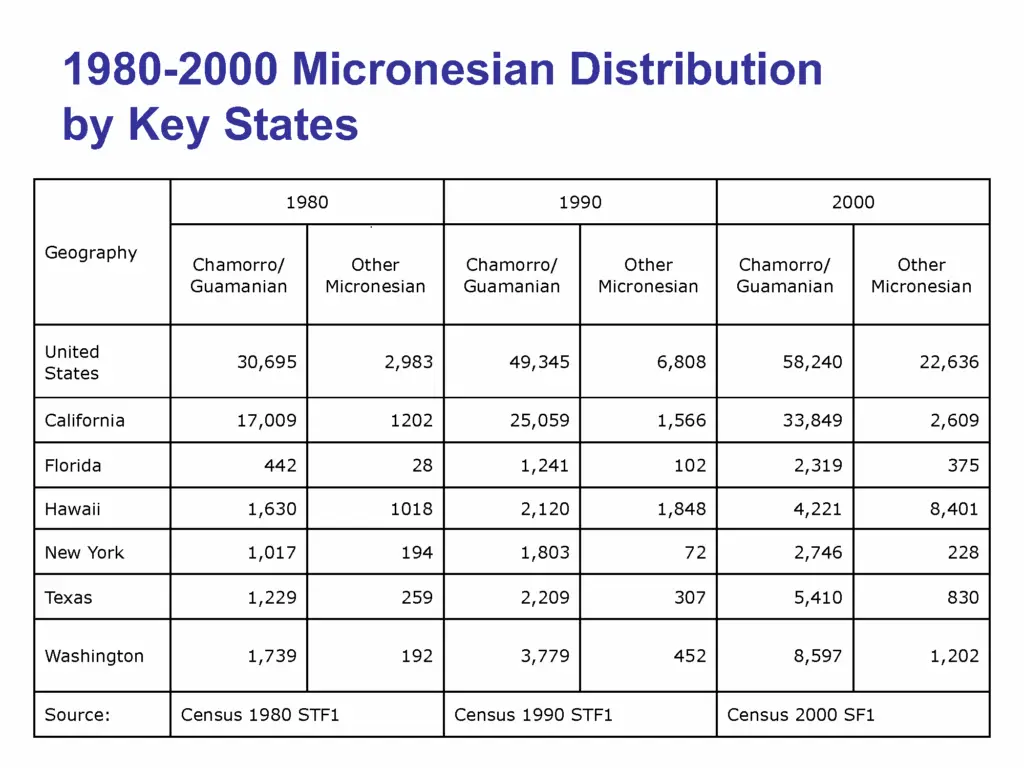
Impact of migration and change in Chamorro society
Migration researchers find that migrant groups are usually those members of society who want change, want to improve their living conditions, and are willing to make the necessary sacrifices. They have also been identified as the “cream of society.” Thus, the Mariana Islands might have lost some of its more vibrant Chamorros as a result of migration. The trend of increasing numbers of Chamorros living away from their home islands of Guam, Saipan, Tinian, and Rota is expected to continue into the next decades.
Such a situation gives rise to concerns surrounding the eventual loss of the Chamorro language and culture in today’s modern Chamorro society. In addition to the migration of Chamorros from their home islands, there is also the rapid and intense force of change created by the “Americanization” of the islands. The economic, social, and political conditions of the islands had practically eradicated the language and cultural institutions among the Chamorros. Existing language use is minimal and cultural traditions and practices have been greatly modified. On the other hand, many of the Chamorro communities in the fifty states continue to observe and practice their Chamorro cultural traditions (such as religious feasts).
There appears to be a rising socio-political consciousness among Chamorros, young and old. The struggle for political recognition and social justice continues among many Chamorros. A Chamorro grassroots organization that cuts across the Mariana Islands has been very effective in bringing together Chamorro leaders from Guam, Saipan, Rota, and Tinian to discuss common issues and common causes, and to advance Chamorro identity. Started in Guam, this organization has held an annual Chamorro Conference in the past three years in Guam (2006), Rota (2007), and Saipan (2008). The fourth conference has been planned for Tinian in 2009. This is the first such organization and gathering among Chamorros since the US occupation of the Mariana Islands.
With the expansion of native dance and music, cultural celebrations, stronger language programs in the schools, all forms of cultural arts and crafts, and greater interest in the research and study of Chamorro history and life, and the increase of Chamorro scholars dedicated to Chamorro issues and concerns, it is clear that a Chamorro renaissance has also begun. With this comes the hope for Chamorro to persevere in the midst of the myriad of forces and challenges facing them today.
By Faye F. Untalan, PhD, MSW, MPH
Footnotes
1 It is important to note that the Decennial Census makes up one part of the US Territorial Censuses conducted in Puerto Rico, the US Virgin Islands, American Samoa, and, more recently, the US Commonwealth of the Northern Marianas; this territorial census is separate and unlike the US Decennial Census conducted within each of the fifty states.
2 The 1970 census did not give a breakdown of the ethnic population in Guam; it identified the population as “native” or “foreign born.” The term, native, was intended to determine the Chamorro native population, but census terminology inadvertently allowed for the counting of non-Chamorros in the native group.)
For further reading
Migration Policy Institute. “Migration Information Source.” Accessed 15 April 2025.
United States Census Bureau. “American Community Survey (ACS).” Last modified 4 February 2025.

